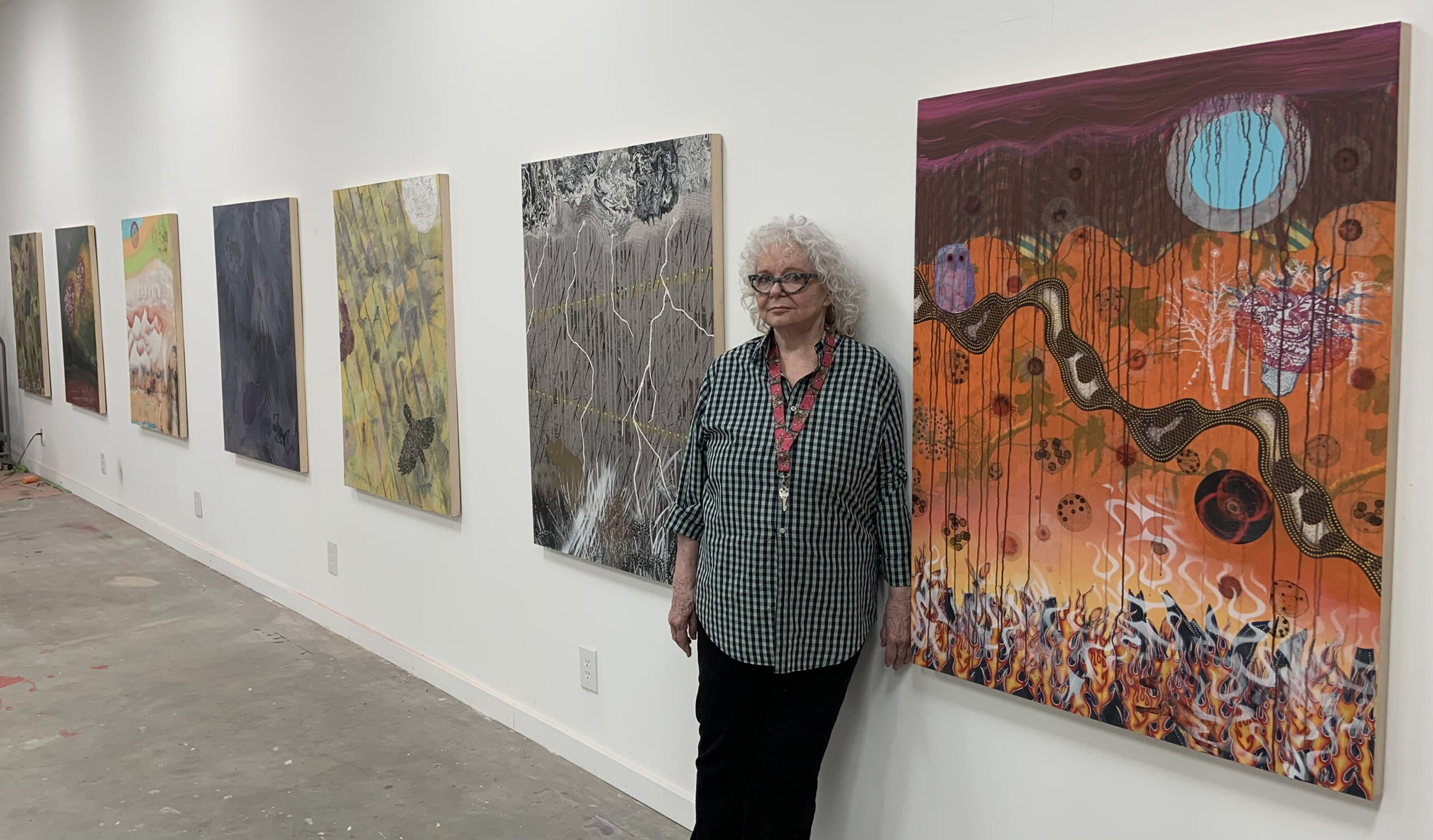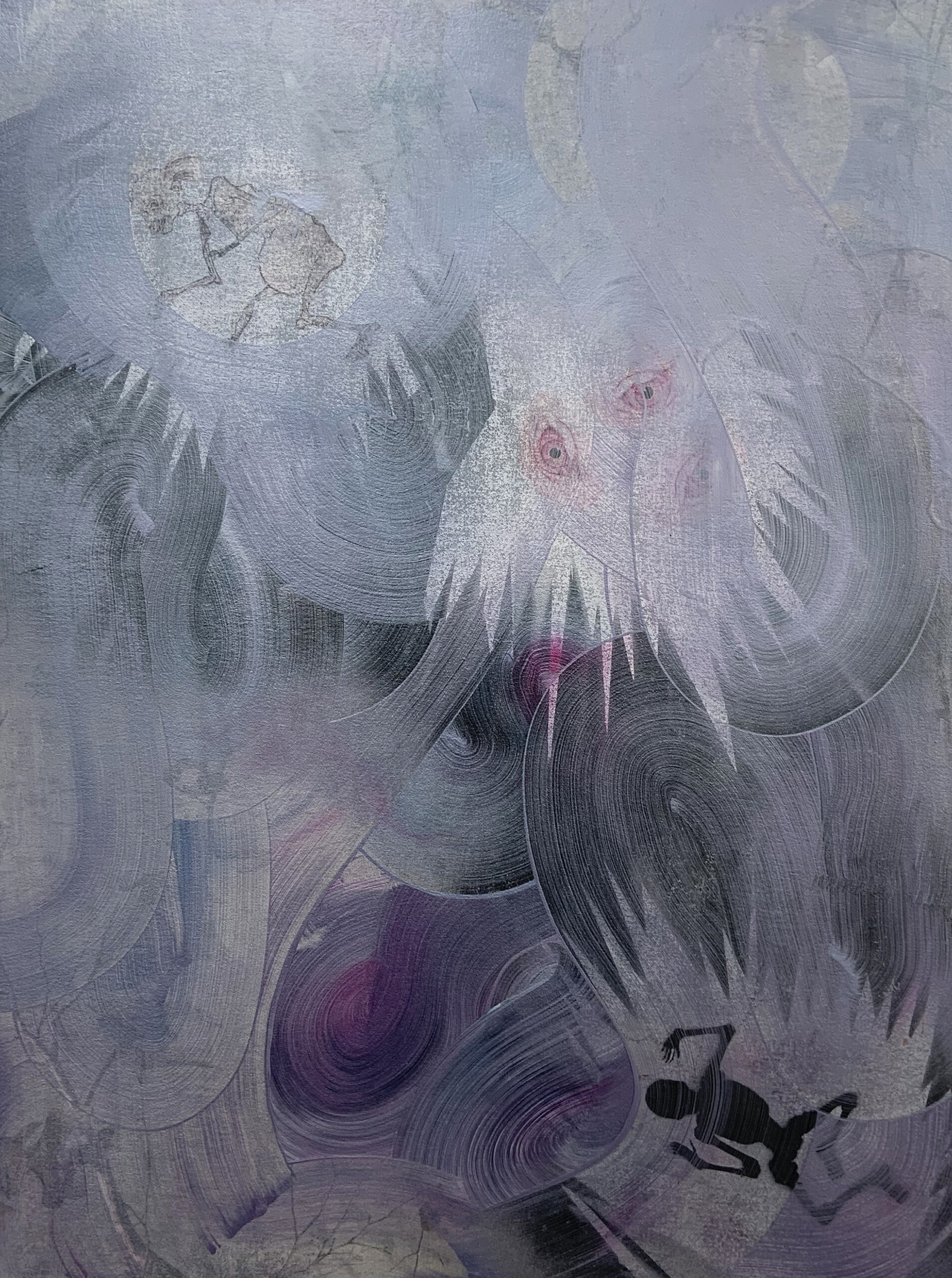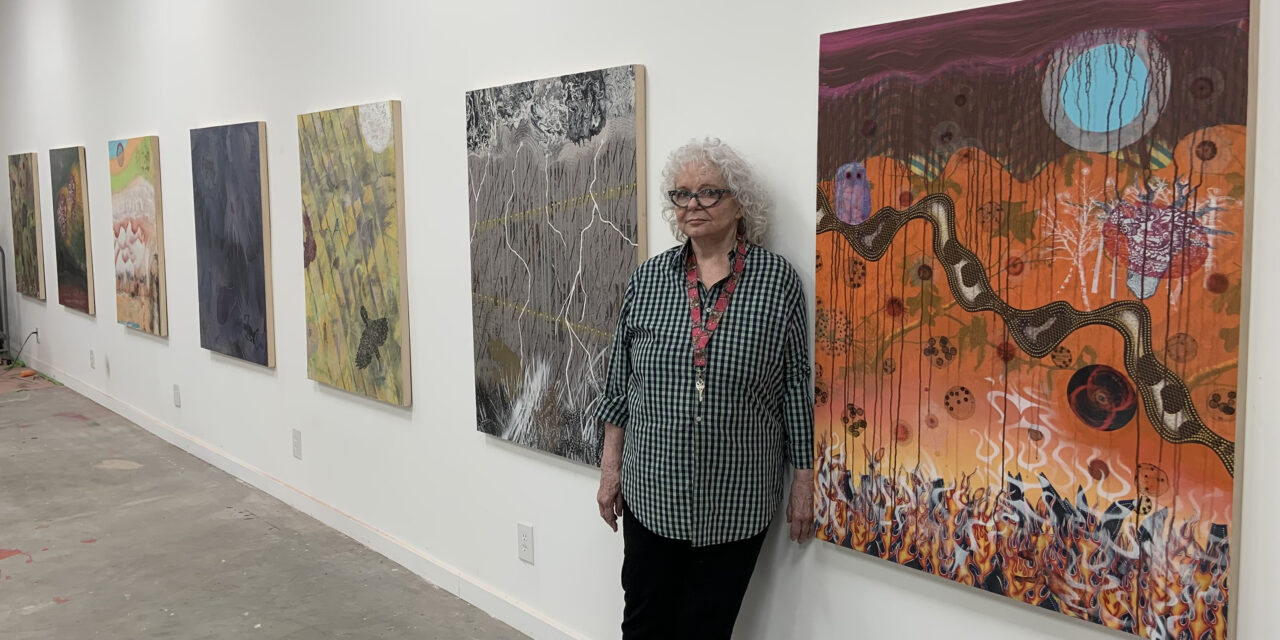 Merion Estes, Studio shot, 2023.
Merion Estes, Studio shot, 2023.
By GARY BREWER, July 2023
“Leave the door open to the unknown, the door into the dark. That’s where the most important things come from, where you yourself came from, and where you will go.”
— Rebecca Solnit, A Field Guide to Getting Lost
I visited the artist Merion Estes in her vast studio just off Old Woman Springs Road, in Yucca Valley, CA. Her studio sits in the High Desert surrounded by cactus, Joshua Trees and ocotillo plants. It is a cool, clean well-lit space filled with her paintings, the desert sun illuminating the space from a dozen or more skylights overhead.
To speak with Estes is to learn about the history of her evolution as an artist and the early feminist artists who drew a line in the sand and challenged the white male-dominated status quo of the art world in the late 1960s and 1970s. Her paintings are an expression of her personal ambition to create powerful paintings of great beauty and emotional depth. They are also part of a collective moment when women artists began to create a language that used pattern and decoration as a philosophical and political statement that challenged the emotionally mute, minimalist and reductive art that dominated the Western contemporary art world.
After she completed graduate school she moved to Los Angeles.
“I was very fortunate that I had a female teacher and mentor in high school and junior college: a wonderful woman, the painter Marj Hyde. It was incredible to me that afterward, during my years as an undergraduate and graduate student, I did not have one female professor. Women artists were so unacknowledged at that time.
Robert Irwin was a visiting professor at the University of Colorado Boulder where I was a graduate student. He was supportive of my work and had an openness and generosity that was remarkable. He introduced me to several artists in Los Angeles, including Vija Celmins and Alexis Smith.
While in graduate school I began participating in women’s groups called Conscious Raising groups. These were gatherings where female artists could share their experiences- both of the unwanted advances made by male professors in art schools and the general attitude that women were not taken seriously as artists. It was an incredible experience; an affirmation of the direction that my work was exploring and an acknowledgment of the negative experiences that women artists had to endure.
When I moved to Los Angeles I joined a feminist group and became one of the founding members of Womanspace Gallery.”
Estes’ work evolved over the years, but her commitment to a maximalist approach to painting has remained a central ethos of her art. When she began using pattern and decoration in her paintings there were few models to follow. At that time, women artists were beginning to create work that expressed a political feminist statement by utilizing forms of craft that were generally considered “feminine”, such as sewing, quilting, and embroidery. These were looked down upon as inferior, and seen through a modernist aesthetic lens as being too sensual, beautiful and ornamental to be taken seriously. Artists like Joyce Kozolff, Miriam Shapiro and others were making powerful works, where ornamentation was a transgressive act and a challenge to the male-dominated art world where beauty and pleasure had been banished. Estes was developing a style and a philosophical approach to paintings that were on the same path. Her work from that period was included in the 2019 exhibition, With Pleasure: Pattern and Decoration in American Art, 1972-1985 at MOCA, Los Angeles.
 Merion Estes, Mutants, Monsters and Ghosts #2, 2021, 48″x36″, spray paint. acrylic on fabric.
Merion Estes, Mutants, Monsters and Ghosts #2, 2021, 48″x36″, spray paint. acrylic on fabric.
Starting in the late 1980s, Estes made a shift away from the rigor of pattern. The power that she achieved using this compositional approach was in part dictated by the systems that ordered and organized the paintings. Grids, repetition and other structures that had been used for creating her paintings began to give way to a desire to work in a free, open and intuitive approach. She wanted to explore the pure potential of paint; letting the hand and mind go and see what a single gestural brush stroke on a loosely applied field of color would inspire. Her current work is a result of this shift in style. Pattern and ornamentation are still present, but they are elements in a free play of intuitive choices made in an expressive approach; each passage an epiphany that inspires the next move.
In a painting such as Mutants, Monsters and Ghosts #2, 2021, a deep field of plum purple is decorated with a rich collection of silhouettes. Plants, microbes, and cellular structures excite the eyes with colorful explosions of form; bold gestural strokes of paint assert themselves as equal players in this dynamic dance. Interspersed are elements of collage: cutout bits of patterned fabrics and images of shadow puppets from Indonesia adorn the painting. Each element is balanced in a complex abstract composition of color and form. These paintings are a palimpsest of Estes’ history, a record and deconstruction of the various elements that have influenced and shaped her journey- but expressed with a fresh and open freedom to move within the limitless possibilities of her imagination.
One senses an element of humor and irreverence in her ‘more is more’ approach. These are the mature works of an artist whose paintings over the decades have followed certain rules and strategies that the artist created to give shape to her paintings. This has given way to a desire to break the rules and shatter any notions of a predetermined design. There is an unapologetic pleasure one feels in the making of these works; an everything, everywhere all at once approach to explore without hesitation the potential of her creativity and expressive depth.
“After years of making paintings that were organized by design systems that determined the final work, I wanted to allow the paint to express its innate potential. A bold gestural stroke of color left alone combined with a bit of African fabric and a silhouette of Godzilla was what I needed! I wanted to free myself and discover each painting without a predetermined structure. It is an exciting time- after moving to the desert and into my new studio, I have created all of these new works.”
 Merion Estes, Mutants, Monsters and Ghosts #10, 2022, 48″x36″, spray paint, acrylic, collage on fabric.
Merion Estes, Mutants, Monsters and Ghosts #10, 2022, 48″x36″, spray paint, acrylic, collage on fabric.
In Mutants, Monsters and Ghosts #10, 2022, a ghostly metallic silver-grey color is applied with a large brush. The arabesques of the loose fluid movement of paint create translucent overlays. The lush strokes move in serpentine pathways, covering a dark background color. Figures and eyes emerge from the vaporous mists. The black silhouette of a dancing skeleton cavorts on the bottom edge, atop a plant form or radiant bursting shape that is also painted in pale silver. Sinister looking eyes emerge from the cloudlike swirls, the red and pink giving them a macabre tone. In the upper left, a strange mythical figure is lurking in the haze. Here and there, passages of purple and pink mix seamlessly with the silver, giving the chromatic environment vortices of mystery and depth. The painting is a free play of imagination engaged with the pure process of painting. The artist is allowing the intuitive sparks of imagination to create narrative fragments that tug one’s interpretation of the image into a strange world of myth and reverie.
Her paintings are chimerical, mutant presences whose DNA freely weaves through histories both personal and drawn from the cultural palette of the world at large. There are ghosts in these paintings, memories of paths taken and themes explored and then left behind. The paintings are in a sense a map of Estes’ life as an artist, woven together in a fresh approach that gives her the freedom to access and use ideas and images from the shape-shifting nature of consciousness.
Being a creative artist is a way of life. It is a means to live in the deep recesses of our human need for images and language that expresses on a profound level, our shared experiences, and vulnerabilities. We are meaning makers, taking the raw information from our five senses and organizing them into beautiful forms to communicate with each other, to try and make sense of the unfathomable mystery of existence.
Merion Estes’ art reflects a long and deep commitment to painting. She has overcome many obstacles and hardships in her life to fulfill her quest to create paintings of great beauty and emotional depth. As we sat in her studio, she expressed a deep satisfaction that her work was a record of her journey, a journey that continues to unfold in paintings that exude a mixture of mystery, beauty, and fearlessness.
Merion Estes’ work is included in the exhibition “Hokusai: Inspiration and Influence From the Collection of the Museum of Fine Arts, Boston” Oct 19, 2023– Jan 21, 2024, Seattle Art Museum. WM




